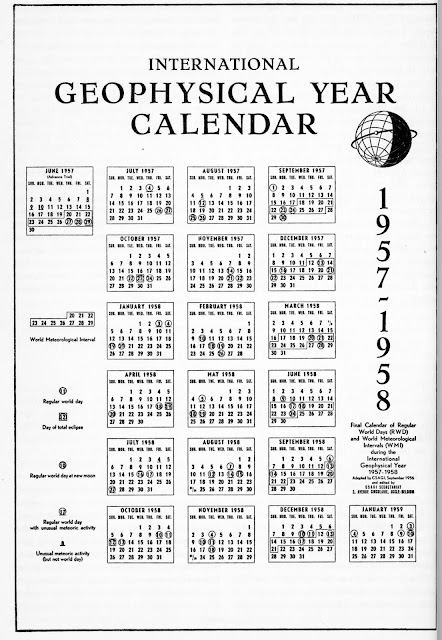The next article in this issue of the IGY Bulletin introduces plans for the Ionopsheric Physics Program. The main part of the program was to send vertical radio wave pulses into the ionosophere that would be reflected back to the Earth's surface and recorded as ionograms. (If you've ever picked up radio stations from hundreds of miles away, that's due to radio waves reflected from the ionosphere, although not vertically.) Unique relationships exist between the frequency of the waves and the electron densities which can reflect it. As the signals sweep across different frequencies, they are reflected from the different layers of the ionosphere. Altitude of the different layers of the ionosphere can be derived from the up-down travel times of the waves. Electron densities in the layers can also be inferred from how much of the upgoing radio wave energy is absorbed before being returned to Earth.
More information on the ionosphere can be derived from naturally occurring radio pulses which originate from lightning discharges, also called sferics. Specific types of sferics are called tweeks and whistlers.
This "sounding" of the ionosphere is somewhat analogous to using seismic waves to probe different layers in the subsurface of the solid Earth. Like with ionosphere probing, the seismic soundings can be based on natural waves from earthquakes, or artificially induced seismic waves, depending on the nature of the study. I've often been impressed how the physics of waves are applicable to so many different phenomena.
The details of the rest of the article are more technical than you (or I) will want to get into, so let's leave it at that.
One international society that focuses on both internal and external aspects of the Earth's magnetic field is the International Society of Geomagnetism and Aeronomy (IAGA). IAGA is organized into six divisions: internal magnetic fields; aeronomic phenomena; magnetospheric phenomena; solar wind and interplanetary field; geomagnetic observatories, surveys and analyses; electromagnetic induction in the Earth and planetary bodies. Aeronomy is a term we haven't encountered here yet; it deals with "the dynamics, chemistry, energetics and electrodynamics of the atmosphere-ionosphere system as well as the coupling processes."
I've been to a number of IAGA meetings which meets every two years, alternating between its own Special Assembly and joint General Assemblies with seven other international scientific associations that are all part of the International Union of Geodesy and Geophysics (IUGG). The IUGG is a non-governmental, scientific organization established in 1919 for international promotion and coordination of scientific studies of the Earth (physical, chemical, and mathematical) and its environment in space.
One of the meetings I went to was IAGA 2009 in Sopron, Hungary. A related stamp was made available to us at the meeting. I bought a pane, and also sent a cover to myself back home. "Magyarország" on the stamp just means Hungary, and "Belföld" is domestic (hence more stamps were added to make up the international rate. I think the instrument in the image is a sun compass. Notice that the selvage (margins of the stamps) on the pane commemorates the meeting.
 |
| Pane of stamps with "IAGA" in the selvage of the stamps, and a plate number in the selvage of the pane |
 |
| Front of IAGA 2009 postcard sent home, with the IAGA postmark |
 |
| Back of the postcard, showing the conference venue, the Liszt Ferenc Conference and Cultural Center |














